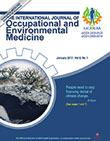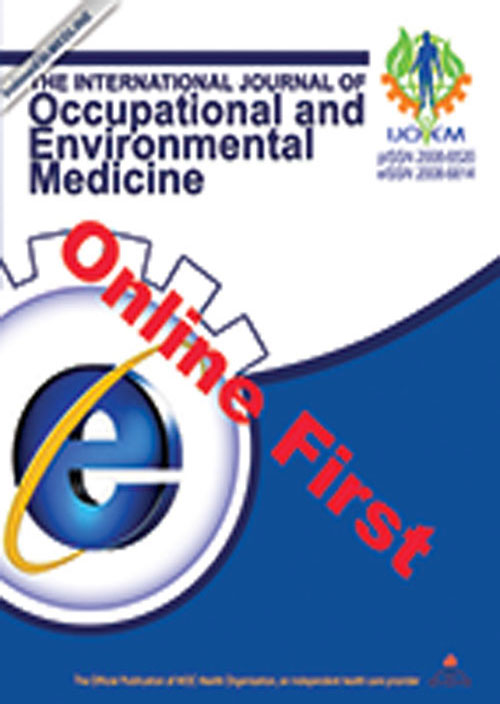فهرست مطالب

International Journal of Occupational and Environmental Medicine
Volume:8 Issue: 1, Jan 2017
- تاریخ انتشار: 1396/01/25
- تعداد عناوین: 13
-
-
Pages 7-20Since the mid-19th century, human activities have increased greenhouse gases such as carbon dioxide, methane, and nitrous oxide in the Earth's atmosphere that resulted in increased average temperature. The effects of rising temperature include soil degradation, loss of productivity of agricultural land, desertification, loss of biodiversity, degradation of ecosystems, reduced fresh-water resources, acidification of the oceans, and the disruption and depletion of stratospheric ozone. All these have an impact on human health, causing non-communicable diseases such as injuries during natural disasters, malnutrition during famine, and increased mortality during heat waves due to complications in chronically ill patients. Direct exposure to natural disasters has also an impact on mental health and, although too complex to be quantified, a link has even been established between climate and civil violence. Over time, climate change can reduce agricultural resources through reduced availability of water, alterations and shrinking arable land, increased pollution, accumulation of toxic substances in the food chain, and creation of habitats suitable to the transmission of human and animal pathogens. People living in low-income countries are particularly vulnerable. Climate change scenarios include a change in distribution of infectious diseases with warming and changes in outbreaks associated with weather extreme events. After floods, increased cases of leptospirosis, campylobacter infections and cryptosporidiosis are reported. Global warming affects water heating, rising the transmission of water-borne pathogens. Pathogens transmitted by vectors are particularly sensitive to climate change because they spend a good part of their life cycle in a cold-blooded host invertebrate whose temperature is similar to the environment. A warmer climate presents more favorable conditions for the survival and the completion of the life cycle of the vector, going as far as to speed it up as in the case of mosquitoes. Diseases transmitted by mosquitoes include some of the most widespread worldwide illnesses such as malaria and viral diseases. Tick-borne diseases have increased in the past years in cold regions, because rising temperatures accelerate the cycle of development, the production of eggs, and the density and distribution of the tick population. The areas of presence of ticks and diseases that they can transmit have increased, both in terms of geographical extension than in altitude. In the next years the engagement of the health sector would be working to develop prevention and adaptation programs in order to reduce the costs and burden of climate change.Keywords: Climate change, Global warming, Weather, Tick-borne diseases, Temperature, Communicable diseases, emerging, Infectious disease medicine
-
Pages 21-31BackgroundCancer has a high mortality rate in both developing and developed countries. 11%15% of cancers are attributable to occupational risk factors.ObjectiveTo determine if specific occupational classes, based on the International Standard for Classification of Occupations 2008 (ISCO-08), are risk factors for gastrointestinal (GI) cancer.MethodsIn this case-control study, 834 cancer patients were interviewed by a single physician. Cases included patients with GI cancer. Age-matched controls were selected from non- GI cancer patients. Each year of working, up until 5 years before the diagnosis, was questioned and categorized by the ISCO classification.Results243 GI cancer cases and 243 non-GI cancer patients (486 in total) were studied. Working in ISCO class 8 (plant and machine operators, and assemblers) was significantly associated with higher risk of GI cancer (OR 1.63, 95% CI 1.05 to 2.52). Working in ISCO class 6 (skilled agricultural, forestry and fishery workers) and 9 (elementary occupations) were also associated with higher incidence of GI cancers.ConclusionWorking in ISCO classes of 8, 6, and 9, which are usually associated with low socio-economic status, can be considered a risk factor for GI cancers.Keywords: Neoplasms, Occupations, Classification, Risk factors, Epidemiology, Gastrointestinal tract
-
Pages 32-38BackgroundWorkers in cotton industry are occupationally exposed to various dust-related hazards. The nature of these agents and the respective exposure levels depend on the cotton industry specific sector. These exposures could be associated with respiratory symptoms and changes in lung function parameters.ObjectiveTo evaluate associations between occupational exposure and respiratory function as well as reported symptoms in several groups of workers at different stages of the cotton industry in a vertical approach that covers all the major sectorsfrom cotton ginning to weaving and fabric production.MethodsA questionnaire on respiratory symptoms and individual as well as workplace characteristics was completed by 256 workers at the cotton industry and 148 office workers (control group). Both groups underwent spirometry.ResultsWorkers in cotton industry reported a higher prevalence of severe dyspnea (p=0.002) and wheezing (p=0.004) compared to the control group. Also they were found to have a lower predicted FEV1% (pConclusionOccupational exposure to cotton dust was associated with increased prevalence of respiratory symptoms and obstructive pattern in pulmonary function test.Keywords: Cotton fiber, Occupational exposure, Signs, symptoms, respiratory, Spirometry, Lung diseases, Byssinosis, Greece
-
Pages 39-45BackgroundDairy farming work involves frequent use of poor postures. These postures may increase the risk of developing musculoskeletal disorders among dairy workers.ObjectiveTo assess postural load during performance of various tasks related to dairy farming.MethodsThis cross-sectional study was conducted on a dairy farm in Iran. In order to assess postural load, tasks related to dairy farming were divided into 3 categories: feeding, milking, and manure disposal. Each task was then divided into its constituent work subdivisions (tasks). Finally, the working posture for each work subdivision was evaluated using Rapid Entire Body Assessment (REBA).ResultsBased on the results from the REBA score, the poorest risk scores (risk level 4) were associated with the following tasks: (1) manure disposal, (2) filling feed bags, and (3) pouring milk into a bucket. Other tasks such as filling corn containers, pouring corn into the milling machine, preparing the feed, pouring food into mangers, attaching the milking machine, and pouring milk from a bucket into a tank imposed high risk (risk level 3). The risk for the tasks of washing and disinfecting the udders were assessed as medium risks.ConclusionThe risk levels associated with most of the tasks on the studied farm were unacceptably high. Therefore, it is essential to implement ergonomic interventions to reduce risk levels of the tasks.Keywords: Human Engineering, Risk factors, Occupational injuries, Musculoskeletal diseases, Dairy products
-
Pages 46-49We conducted this study to determine the risk of transmission of Q fever to health care workers (HCWs) during perioperative exposure to Coxiella burnetii-infected thoracic endovascular aneurysm stent graft. Pre-operative and 6-week post-operative phase I and II IgG Q fever antibody titers were determined in 14 staff members of an operation room. The room had a negative pressure and all the members of the surgical team wore either a fitted N-95 mask or a powered purified air respirator. Phase I and II IgG antibody titers wereKeywords: Coxiella burnetii, Q fever, Infection control, Health personnel, Personal protective equipment, Operating rooms, Stents
-
Pages 50-55A 69-year-old woman was admitted to hospital 4 times from November 2007 to June 2009. The patient had silicosis complicated by broncholithiasis, esophagobronchial fistula, and relapsed tuberculosis. She had worked as a stone crusher for 3 years and was exposed to a large amount of quartz dust. Barium esophagography, gastroesophageal endoscopy, and biopsy suggested esophageal-related chronic inflammation and ulcer, which probably caused the repeated esophagobronchial fistulas observed. Bronchoscopy revealed a free broncholithiasis in the left main bronchus. The patient was readmitted a fourth time, for the relapse of silicotuberculosis. After 9 months of antituberculous therapy, she was doing well until the recent last follow-up visit.Keywords: Silicosis, Esophagus, Fistula, Tuberculosis, Lung diseases
-
Page 62
-
Pages 63-64


